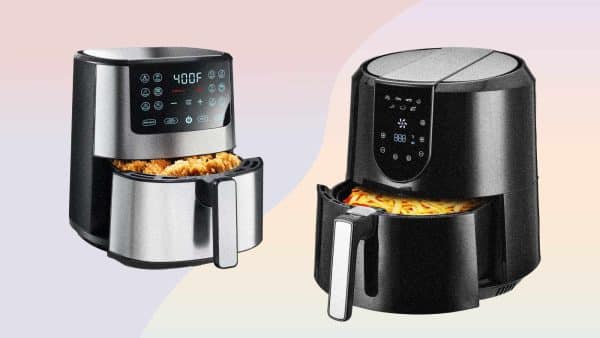Let’s take a closer look at air fryers and traditional frying methods to determine which one is a healthier option.
While both methods result in deliciously crispy foods, air fryers claim to achieve the same crispy texture with significantly less oil.
This article will explore the pros and cons of air fryers compared to traditional frying, shedding light on whether this trendy appliance truly lives up to its promise of healthier cooking.
Health Benefits of Air Fryers
Reduced Fat Intake
Air fryers have gained popularity regarding cooking methods due to their ability to reduce fat intake significantly. Traditional frying methods often require a large amount of oil to submerge the food, resulting in high-fat content in the final dish.
However, air fryers use hot air circulation to cook the food, requiring only a minimal amount of oil or sometimes none. This means you can enjoy delicious fried foods with a fraction of the fat content.
Decreased Risk of Chronic Diseases
Air fryers can decrease the risk of chronic diseases by reducing the amount of fat consumed.
Excessive consumption of fried foods, especially those cooked using traditional frying methods, has been linked to various health issues, including heart disease, obesity, and high cholesterol levels. You can still indulge in your favorite fried dishes with air frying without compromising your health.
Lower Calorie Consumption
Not only do air fryers reduce fat intake, but they also result in lower calorie consumption. Since air frying requires minimal or no oil, you can significantly cut down on the overall calorie content of your meals. This can be particularly beneficial for those trying to lose or maintain a healthy weight. By replacing deep-fried foods with air-fried alternatives, you can enjoy guilt-free indulgence.
Retained Nutrients in Food
One of the advantages of air frying is that it helps retain the nutrients in your food. Traditional frying methods, which require longer cooking times and higher temperatures, can lead to nutrient loss.
Air fryers, on the other hand, use rapid air circulation to cook food quickly, preserving more of its nutritional value. This means you can still enjoy flavorful meals while ensuring you get the most out of the ingredients.
Cooking Process
How Air Fryers Work
Air fryers utilize a unique cooking process that differentiates them from traditional frying methods. These appliances use hot air circulation to cook food, similar to a convection oven. The air fryer’s heating element warms up the air inside the cooking chamber, and a fan circulates the hot air at high speeds. This circulation cooks the food from all angles, producing crisp and evenly cooked dishes.
Traditional Frying Process
In contrast, traditional frying involves submerging food in hot oil. The oil’s high temperature quickly cooks the food’s outer layer, creating a crispy texture. However, this method often leads to a higher fat content and can result in unevenly cooked food if not done correctly. Traditional frying typically requires more significant amounts of oil, which can contribute to increased calorie consumption and potential health risks.
Temperature and Cooking Time Comparison
Air fryers generally operate within a temperature range of 300 to 400 degrees Fahrenheit (149 to 204 degrees Celsius). Traditional frying methods, on the other hand, typically require oil to be heated to higher temperatures, ranging from 350 to 375 degrees Fahrenheit (177 to 191 degrees Celsius).
In terms of cooking time, air frying often takes less time than traditional frying, thanks to the rapid hot air circulation. This can be a significant advantage for those who value convenience and want to save time in the kitchen.
Reduced Oil Usage
Minimal Oil Requirements
One of the key benefits of air fryers is their ability to cook food with minimal oil requirements. While some recipes may call for a light oil coating on the food, others can be cooked without any oil. This not only helps reduce the fat and calorie content of the dish but also eliminates the need for excessive oil usage.
Impact on Health
Reducing oil usage can have a positive impact on your health. Excessive oil consumption, significantly high in saturated or trans fats, can contribute to weight gain, high cholesterol levels, and an increased risk of heart disease. Using an air fryer, you can maintain the desired texture and flavor of fried foods while significantly reducing your oil intake.
Comparison to Traditional Frying
When comparing air frying to traditional frying, it is clear that air fryers offer a healthier alternative. Traditional frying often requires a generous amount of oil to submerge the food, resulting in higher fat absorption.
On the other hand, air frying achieves similar results in terms of texture and taste with minimal or no oil. By switching to air frying, you can enjoy your favorite fried dishes with less guilt and improved health outcomes.
Crispy Texture and Taste
Achieving Crispy Results
One concern many people have when considering air fryers is whether they can achieve the same level of crispiness as traditional frying methods. The answer is a resounding yes!
Air fryers can produce crispy results by utilizing the hot air circulation and the Maillard reaction, which is responsible for browning and crisping food. While it may not be identical to deep-fried foods, the texture and taste are remarkably similar.
Comparing Texture with Traditional Frying
When it comes to texture, air frying can deliver satisfying results. The hot air circulation in air fryers helps create a crispy outer layer while retaining the moisture inside.
This results in a pleasantly crunchy texture without compromising the tenderness of the food. While some die-hard fans of traditional frying may argue that deep-frying provides a superior texture, air frying offers a healthier alternative that still satisfies the craving for crispy indulgence.
Flavor and Browning
Air fryers excel at achieving a beautiful golden-brown color on the food, reminiscent of traditionally fried dishes.
The Maillard reaction, which occurs when proteins and sugars react at high temperatures, gives food its desirable browned appearance and enhances flavor. Air frying harnesses this reaction, enabling you to enjoy well-browned and flavorful dishes without excessive oil usage.
Health Risks and Concerns
Acrylamide Formation
One potential health concern associated with cooking certain foods, including starchy vegetables and grains, at high temperatures is acrylamide formation.
Acrylamide is a chemical compound that forms when certain carbohydrates are exposed to high heat, such as frying or baking. While air frying can also lead to some acrylamide formation, research suggests it may be lower than traditional frying methods.
Harmful Compounds in Fried Foods
There is a risk of generating harmful compounds when cooking foods at high temperatures, whether through traditional frying or air frying. Acrolein, for example, is a byproduct of heating oil and can contribute to respiratory and eye irritations.
Polycyclic aromatic hydrocarbons (PAHs) are another group of compounds that can form during high-temperature cooking and have been linked to an increased risk of cancer. However, it is worth noting that air frying can potentially reduce the formation of these compounds due to the lower temperatures and reduced oil usage.
Potential Health Risks of Air Fried Foods
While air frying offers several health benefits, it is essential to acknowledge that individual dietary choices and eating habits significantly determine overall health.
Air frying alone cannot compensate for an unhealthy diet, and regularly consuming fried foods, even if air-fried, may still contribute to weight gain and other health issues. Maintaining a balanced and varied diet, incorporating plenty of fruits, vegetables, whole grains, and lean proteins, is essential while minimizing the consumption of fried and processed foods.
Effect on Weight Loss
Air Fryers and Weight Management
For those on a weight loss journey or aiming to maintain a healthy weight, air fryers can be a valuable tool.
By reducing the amount of oil and calories consumed, air frying allows you to enjoy your favorite fried foods without derailing your weight loss goals. However, it is essential to remember that portion control and overall dietary choices remain crucial factors in achieving and maintaining weight loss.
Impact on Caloric Intake
Air frying can significantly impact caloric intake by reducing the overall calories in a dish. Since air fryers require minimal or no oil, you can enjoy lower-calorie versions of fried favorites, such as French fries or chicken wings.
You can create a well-rounded, satisfying diet that supports weight management by pairing air frying with other healthy cooking techniques and incorporating various nutrient-rich foods into your meals.
Influence on Dietary Choices
Air fryers may also indirectly impact dietary choices by making healthier cooking alternatives more accessible. Instead of relying on heavily processed and calorie-laden convenience foods, air fryers allow you to prepare homemade versions of your favorite fried dishes.
This helps control the ingredients and nutritional content and empowers you to make conscious choices regarding the quality and quantity of the foods you consume.
Safety Considerations
Preventing Burns
As with any cooking appliance, taking safety precautions when using an air fryer is crucial. The cooking chamber and components of the air fryer can become extremely hot during operation.
Always use oven mitts or protective gloves when handling the air fryer, and avoid touching hot surfaces to prevent burns. It is also advisable to keep children and pets away from the appliance while it is in use.
Avoiding Aerosolized Oil
While air frying significantly reduces oil usage compared to traditional frying, there is still a possibility of oil splatter and aerosolized oil particles during the cooking process.
To minimize the risk, ensure your air fryer is correctly cleaned before each use and place it in a well-ventilated area. This reduces the chances of encountering hot oil particles and helps maintain a safe cooking environment.
Maintenance and Cleaning Tips
Proper air fryer maintenance and cleaning are essential for both safety and optimal performance. After each use, allow the air fryer to cool down before cleaning. Most air fryers have dishwasher-safe components, making cleaning a breeze.
Remove excess oil or food debris from the cooking chamber and accessories to prevent odor buildup and potential safety hazards. Regular maintenance and cleaning will prolong the lifespan of your air fryer and ensure safe and healthy cooking experiences.
Convenience and Time Savings
Quicker Cooking Process
Air fryers offer a significant advantage in terms of cooking time. The hot air circulation in air fryers allows food to cook more rapidly than traditional frying methods.
This can be especially beneficial when preparing quick and easy weeknight meals or when you’re short on time. With an air fryer, you can have perfectly crispy and delicious dishes on the table in a fraction of the time it would take using traditional frying methods.
Ease of Use and Multifunctionality
Another aspect that makes air fryers appealing is their ease of use and multifunctionality. Most air fryers come with user-friendly controls and pre-programmed settings, making them suitable for experienced and novice cooks.
Additionally, many air fryers offer the added convenience of cooking functions other than air frying, such as baking, grilling, and roasting. This versatility allows you to experiment with different cooking techniques and expand your culinary repertoire.
Reduced Cooking Odors
Traditional frying often comes with the lingering smell of oil and fried food in your kitchen. Air fryers, on the other hand, help minimize cooking odors.
The enclosed cooking chamber and the reduced oil usage contribute to a cleaner cooking experience with fewer lingering smells. This can be particularly beneficial for those living in smaller spaces or with a sensitive sense of smell.
Price Comparison
Initial Investment
When considering purchasing an air fryer, the initial investment is an essential factor to consider. Air fryers come in various prices, depending on the brand, size, and features.
While some models may be pricier, more affordable options are also available. Considering their potential health benefits and convenience, an air fryer can be a worthwhile investment in your overall well-being.
Additional Costs
While the upfront cost of an air fryer is a one-time expense, it is essential to consider any additional costs that may arise. Depending on the frequency of use and the type of food you cook, you may need to replace specific components, such as the cooking basket or accessories, over time.
Also, consider the cost of ingredients, including oil or non-stick sprays, which may still be required for specific recipes or personal preferences.
Long-Term Savings
In the long run, air fryers can contribute to potential cost savings. By reducing oil usage, you can save on regular oil purchases, as well as lower your consumption of high-calorie convenience foods.
Additionally, air frying allows you to recreate your favorite fried dishes at home, eliminating the need for takeout or dining at restaurants. Over time, these savings can add up, making an air fryer a cost-effective option for healthy cooking.
Environmental Impact
Energy Consumption
When it comes to energy consumption, air fryers generally use less energy compared to conventional ovens or deep fryers.
Their compact size and quick cooking times contribute to reduced energy usage, making them more energy-efficient alternatives. By using an air fryer, you can contribute to conserving energy and reducing your carbon footprint in the kitchen.
Waste Generation
Traditional frying often results in large amounts of cooking oil waste, which can be challenging to dispose of properly. Improper disposal can lead to environmental pollution and negative impacts on ecosystems.
You can significantly reduce the amount of cooking oil waste generated with air fryers. Air-fried dishes require minimal or no oil, resulting in less waste and a more eco-friendly cooking experience.
Sustainability Features
As the demand for more sustainable kitchen appliances grows, manufacturers have started incorporating eco-friendly features into air fryer designs.
Some models include energy-saving modes or timers that automatically power off the device after a certain period of inactivity. Additionally, specific components are now made with recyclable or biodegradable materials, further reducing the environmental impact. These sustainability features make air fryers a more environmentally conscious choice for your kitchen.
In conclusion, air fryers offer a healthier alternative to traditional frying methods, with several benefits ranging from reduced fat intake to retained nutrients in food. By utilizing hot air circulation, air fryers can achieve a crispy texture and taste that rivals traditional frying while minimizing the use of oil.
While there are some health risks and concerns associated with high-temperature cooking, air fryers have the potential to contribute to weight loss efforts and offer convenience and time savings in the kitchen.
Additionally, air fryers can have a positive environmental impact, with reduced energy consumption and waste generation. Considering all these factors, it’s clear that air fryers can be a valuable addition to your kitchen, promoting healthier cooking habits and contributing to overall well-being.



































